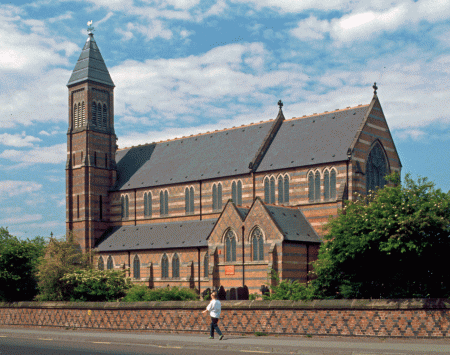Church of St Cross, Ashton New Road, Clayton, Manchester
"To enjoy a church like All Saints, London one must wear smoked glasses. At St. Cross the deposited smoke of Manchester saves one the trouble". Cecil Stewart
Generally William Butterfield drew his patronage from the old aristocracy, the arbiters of taste in the metropolis, rather than the nouveau riche industrialists of the provinces. St. Cross is, therefore, one of the few examples of the work of William Butterfield in the industrial North-West of England. Designed as a "town church", it was built to further the aims of the Oxford Movement, to bring the urban working class back to religion. The site chosen for the new church was part of the Clayton Hall Estate. This had been inherited through the female line of Sir Humphrey Chetham's descendants by Peter Richard Hoare, a London banker and it was Hoare who commissioned Butterfield to design the church. This land, to the west of Clayton Hall was on the edge of urban development and still relatively open. The church was not intended to destroy the urban townscape but was intended to dominate its setting, acting as a focus.
Although a "town church", the setting of the building has become shrouded in myth, with Paul Thompson writing poetically of "Its majestic walls, soot-stained from mill-smoke, rising shear from a melancholy sea of brick terraces". Although later developments encroached ever nearer, at the time of its construction, the church was built with an extensive church yard, on open land some distance away from the built-up area, not on a tight urban site as All Saints in London.
The church was to have been named the "Church of the Holy Cross" but Bishops Prince Lee and Fraser both made objection to the name. It was eventually consecrated by Bishop Fraser on 11 August 1874 as the "Church of Saint Cross", a compromise possibly reached as a result of Butterfield's restoration of St. Cross at Winchester.
